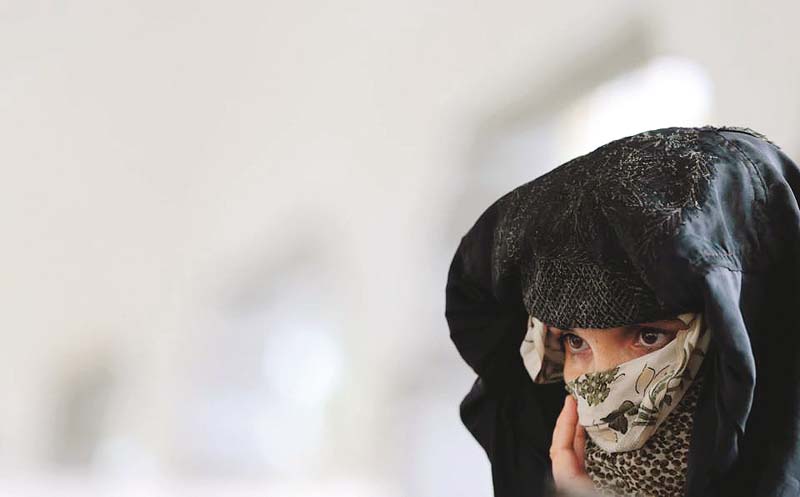

Historically in Waziristan, whether in wars fought between tribes or external wars, all tribes abided by and defended the “Wazirwalla,” an unwritten code of law that governed the region. The elders who were members of the jirga would make decisions according to the Wazirwalla, locally known as “Waziri qanun”. The code gets its name from Wazir, the forefather of both the main tribes, the Wazir (Darvesh Khel) tribe and the Mehsud tribe.
The new order
The Wazirwalla was the first ever rivaj or custom law among the Pakhtuns. It was governed by an independent jirga of elders and sanctioned by armed tribal militias (lashkars). But in the 19th Century, the British introduced the Frontier Crimes Regulation (FCR) after which the jirga’s law became dependent on the new set of laws that to date govern Waziristan.

Internally displaced children from North Waziristan play at a school in Bannu. PHOTO: AFP
The FCR jirgas were considered the official decision-making authority and started functioning as a parallel system. However, they too followed the Wazirwalla. The British, through the FCR jirga, curtailed the political power of the tribes, but they did not question or interfere in the overall governing code.
During the Cold War era, independent tribal jirgas took new form. Religious clerics became part of the jirga and the elders and clerics, known as mullahs, started making decisions according to the Wazirwalla as well as the Shariah. The mullahs were mostly from within the tribes and abolished or altered several sections of the Wazirwalla code. It was mostly cultural rituals that were targeted, which first led to the custom of wearing burqas or doing parda in public spaces. The strict parda reduced women’s role in culture, politics and society, and this resultantly had economic implications.

An internally displaced girl looks through a scarf covering her face amid other women waiting to be registered at the camp. PHOTO: REUTERS
Previously, the newly-married woman would take the cattle up a mountain early every morning for three days and girls and boys would sing and dance together to celebrate the arrival of spring. “Women were not limited to their homes. We used to go outside our home without wearing a burqa. In fact, we did not even know what a burqa was. We were only familiar with ganr khat (a cultural dress worn by married women),” says Gul Meena, a resident of Waziristan, who has witnessed the changes in society from the time of the Afghan jihad.
Since the 9/11 attacks on the Twin Towers, this mindset that hinges on religion has posed a multi-dimensional threat,w particularly with respect to Internally Displaced Persons (IDPs). South Waziristan’s Mehsud tribe was displaced after Operation Rah-e-Nejat in 2009, and North Waziristan’s Uthmanzai tribe was displaced after Operation Zarb-e-Azb last year. The societal makeup and cultural trends of Waziristan were severely impacted by these displacements. Wana, a sub-division of South Waziristan, is one area that is still inhabited by a tribe, the Ahmedzai. Here, even today, the Wazirwalla is followed. In some areas, it is practiced in its original form, while religious clauses have been added to other areas.
A wave of change
Tribes from Waziristan were traditionally nomadic. They would live in tents and depend on cattle, shifting from one place to another depending on the weather conditions. However, with time people started settling in mud houses, but both men and women were still part of all socio-economic activities. The democratic and secular governing code of Wazirwalla kept a distance between the home and the mosque.

Men belonging to the Wazir and Dawar tribes of North Waziristan perform a ‘dance of death’ to register their protest against shelling in the region in 2013. PHOTO: FILE
Clerics would only be included to hold congregational and funeral prayers, read the nikkah and raise their hands for dua (prayer) at the end of the jirga. Before the Afghan jihad period, many jirga elders were musicians and singers, says 82-year-old Akbar Khan, a native of Waziristan. If a jirga was held for war or peace, tribal elders would perform the attan (a traditional dance) at the end of the congregation.
Women would freely travel to markets, climb mountains to collect firewood and take the cattle for walks. They voiced their opinion in jirgas, were involved in warfare, and would also participate in sports. Even today, in some areas of Waziristan, burqas are not worn and it’s only when women travel to settled parts of Pakistan, such as Tank or Bannu, that they cover themselves.
Researcher Dr Fazlu Rehman, who studies the culture and life of the tribal region, says burqas were not worn in any part of the tribal belt. Women only wore large dupattas. Even Dr Rehman connects the appearance of burqas to changing circumstances after the Afghan jihad, when tribes intermingled with people in settled areas and inter-marriages took place.
Secular affairs
Previously, people of Waziristan were secular and wedding rituals would be performed according to the Wazirwalla code, which, among other things, allowed for marriage of choice. As dictated by the zagh pa waka tradition, men would indulge in aerial firing outside the prospective bride’s home and then the jirga, together with the consent of the girl’s family, would pick the groom. “There was nothing shameful or out of the ordinary about marrying out of choice. It has been going on for centuries and it’s unfortunate that it no longer exists here today,” says Khan. With the introduction of parda in society, women were cut off from public life and compulsion came in marriage. Engagements started happening without the man or woman seeing each other.

A girl from Miranshah in North Waziristan who moved to Bannu after a military operation was launched in the region last year. PHOTO COURTESY: SHOAIB TARIQ
Earlier, folk songs narrating stories of history, beauty, love and bravery were sung at weddings. While the attan is still part of wedding ceremonies, a lot has changed. “Earlier, a Barragai attan would be performed at weddings and this involved both men and women dancing to a drum beat around a fire. Now, that rarely ever happens,” says Khan. “In our time, the Barragai used to be performed publicly,” he adds. Describing the numerous cultural rituals that have now disappeared, he says, “Earlier, the bridegroom would sit on the back of a female camel, while men and women on foot would go with him dancing and singing till the camel reached the bride’s home. Now people come in a car and there is no fun in that.”
The impact of development
Other changes came about with development in the country, despite the fact that little of that development was carried out in the tribal region. This happened particularly during Zulfikar Ali Bhutto’s reign when schools were opened, road infrastructure improved and electricity provided. It became easier for people to travel from one place to another and they were introduced to a different way of life.

Similarly, technology also played a substantial role in cultural changes. One example of this is when the tape recorder first came to Waziristan. There were no telephones at the time and men and women would record songs, duas and salams on cassettes and dispatch them to relatives residing in Gulf countries. But when telephones came, this cultural trend disappeared. While there is no internet in the area, there is access to mobile phones in Wana. But men try to keep women away from technology and prevent them from watching videos and learning more about life outside the tribal belt.
At the same time, there was pressure from mullahs and the Taliban to denounce technology. In Wana’s Rustam bazaar, there have been frequent attempts by Mullah Nazir’s Taliban group to reduce people’s access to technology. Computers, cameras and mobile phone stores have been set on fire for being against Shariah and culture. But there is only so much that they have been able to keep out. People still have access to satellite and interact with transporters and truck drivers in other parts of Pakistan and the Middle East for business. This keeps them linked with the outside world despite various restrictions.
Return to roots
Despite the changes over time, tribes in Waziristan are still inclined towards their culture and some old ways of life. While women are no longer part of dance performances at weddings, the attan does still exist — if only for men. In some places, there are also signs of people adopting the old style of marriage. With the IDPs returning to their homes, it may perhaps be a matter of time before things come full circle and Waziristan embraces its cultural roots.
Zulfiqar Ali is a Peshawar-based reporter for The Express Tribune.
Published in The Express Tribune, Sunday Magazine, May 3rd, 2015.


1725030039-0/Untitled-design-(2)1725030039-0-165x106.webp)
1725366721-0/kyle-(1)1725366721-0-165x106.webp)
1731410017-0/BeFunky-collage-(45)1731410017-0-165x106.webp)












COMMENTS (4)
Comments are moderated and generally will be posted if they are on-topic and not abusive.
For more information, please see our Comments FAQ